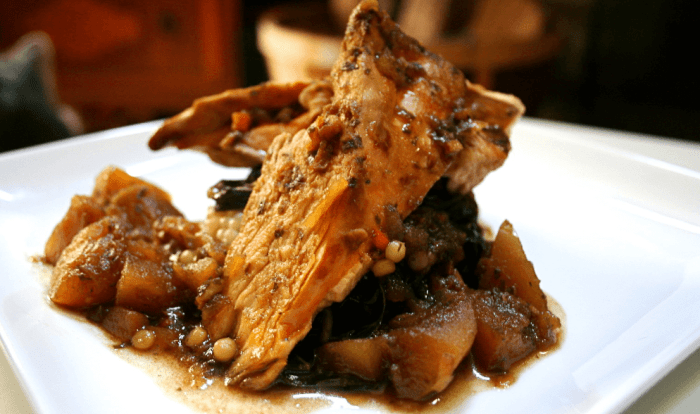
Chicken of the woods recipe is a culinary adventure that will tantalize your taste buds and ignite your imagination. This unique mushroom, with its vibrant colors and meaty texture, offers a symphony of flavors that will elevate any dish. Join us as we explore the versatility and deliciousness of chicken of the woods, from its nutritional benefits to its culinary applications.
Whether you’re a seasoned forager or a curious cook, this guide will provide you with all the essential knowledge and inspiration to make the most of this extraordinary ingredient. So, let’s dive into the world of chicken of the woods and discover the culinary possibilities that await!
Introduction to Chicken of the Woods Recipe

Chicken of the woods is a unique and delicious mushroom that has a texture similar to chicken. It is a bright orange color and has a slightly sweet flavor. Chicken of the woods is a good source of protein, fiber, and vitamins.
It is also low in calories and fat.
Chicken of the woods is a versatile mushroom that can be used in a variety of dishes. It can be grilled, roasted, sautéed, or fried. It is also a good addition to soups, stews, and casseroles.
Nutritional Value and Health Benefits
Chicken of the woods is a good source of several nutrients, including protein, fiber, vitamins, and minerals. It is also low in calories and fat. Here is a breakdown of the nutritional value of chicken of the woods:
- Calories: 30 per cup
- Protein: 3 grams per cup
- Fiber: 2 grams per cup
- Vitamin C: 10% of the Daily Value (DV)
- Vitamin D: 10% of the DV
- Potassium: 10% of the DV
- Iron: 6% of the DV
Chicken of the woods has several health benefits, including:
- It is a good source of antioxidants, which can help protect cells from damage.
- It has anti-inflammatory properties, which can help reduce inflammation throughout the body.
- It is a good source of beta-glucans, which are compounds that have been shown to boost the immune system.
Availability and Seasonality
Chicken of the woods is a seasonal mushroom that is typically found in the fall. It can be found in deciduous forests throughout North America and Europe. Chicken of the woods is a relatively common mushroom, but it can be difficult to find in some areas.
If you are unable to find chicken of the woods in your local area, you can purchase it online or at specialty grocery stores.
Preparing Chicken of the Woods
Chicken of the woods, a flavorful and versatile mushroom, requires proper preparation to enhance its culinary value. Cleaning and preparing this mushroom involve removing dirt and debris, cutting it into manageable pieces, and understanding its unique characteristics.
Cleaning Chicken of the Woods
Cleaning chicken of the woods is crucial to remove any dirt or debris that may have accumulated during its growth. Gently brush off loose dirt using a soft brush or a damp cloth. For stubborn dirt, rinse the mushroom briefly under cold running water and pat it dry with paper towels.
Avoid soaking the mushroom as it can absorb excess moisture, affecting its texture and flavor.
Cutting Chicken of the Woods
Once cleaned, cut the chicken of the woods into manageable pieces suitable for your intended cooking method. Smaller pieces are ideal for sautéing or stir-frying, while larger chunks can be grilled or roasted. Use a sharp knife to make clean cuts, avoiding tearing the mushroom’s delicate flesh.
Cooking Chicken of the Woods
Chicken of the woods can be cooked using various methods, each imparting a unique flavor and texture. Sautéing or stir-frying over medium heat brings out its savory and slightly nutty flavor. Grilling or roasting at high temperatures caramelizes the mushroom’s surface, creating a crispy exterior and a tender interior.
Storage and Handling, Chicken of the woods recipe
Proper storage and handling techniques are essential to preserve the freshness and flavor of chicken of the woods. Store the mushroom in a paper bag or a breathable container in the refrigerator for up to 5 days. Avoid storing it in plastic bags as they can trap moisture and promote spoilage.
Cook the mushroom as soon as possible after harvesting or purchasing to enjoy its optimal flavor and texture.
Recipe Variations for Chicken of the Woods: Chicken Of The Woods Recipe
Chicken of the woods is a versatile mushroom that can be used in a wide variety of dishes. It has a meaty texture and a slightly nutty flavor, making it a great substitute for chicken in many recipes.
Here are a few ideas for how to use chicken of the woods in your cooking:
Stir-fries
Chicken of the woods is a great addition to stir-fries. It can be sliced into thin strips and cooked with your favorite vegetables and sauce.
Soups and stews
Chicken of the woods can also be used in soups and stews. It adds a hearty flavor and texture to these dishes.
Salads
Chicken of the woods can be used in salads as well. It can be sliced or shredded and added to your favorite salad greens.
Vegan and vegetarian adaptations
Chicken of the woods is a great option for vegans and vegetarians who are looking for a meaty substitute. It can be used in any of the recipes above, and it will provide a similar flavor and texture to chicken.
Culinary Applications of Chicken of the Woods
Chicken of the woods is a versatile culinary delight that finds its way into diverse cuisines worldwide. Its meaty texture and mild flavor make it an excellent substitute for chicken in various dishes, while its nutritional profile adds a boost of vitamins, minerals, and antioxidants.
This edible mushroom pairs well with an array of meats, including beef, pork, and lamb. Its ability to absorb flavors makes it a perfect companion for savory sauces and marinades, enhancing the overall taste experience.
Incorporating Chicken of the Woods into Dishes
Chicken of the woods can be incorporated into dishes in numerous ways, adding both flavor and nutritional value. Some popular culinary applications include:
- Stir-fries and Sautéed Dishes:Chicken of the woods adds a meaty texture and umami flavor to stir-fries and sautéed dishes. It pairs well with vegetables like broccoli, carrots, and onions.
- Soups and Stews:The mushroom’s meaty texture makes it an excellent addition to soups and stews, adding depth and flavor to these hearty dishes.
- Pizza and Pasta Toppings:Chicken of the woods can be used as a topping for pizzas and pastas, providing a unique and flavorful twist on these classic dishes.
- Fried or Roasted:Frying or roasting chicken of the woods creates a crispy exterior and tender interior, making it a delicious appetizer or side dish.
Preserving and Storing Chicken of the Woods

Chicken of the woods can be preserved through various methods, extending its shelf life and allowing for future culinary enjoyment. Preserving techniques include drying, freezing, and canning, each with its advantages and considerations.
Craving a delicious and unique culinary experience? Look no further than the chicken of the woods recipe . This delectable mushroom, with its vibrant colors and meaty texture, can be transformed into a delectable dish that will tantalize your taste buds.
The recipe is incredibly versatile, allowing you to customize it to your liking, whether you prefer a savory stir-fry or a creamy soup.
The preservation method employed can influence the flavor and texture of chicken of the woods. Understanding the impact of these techniques helps ensure optimal results when preparing and storing this versatile fungus.
Drying
Drying is an effective method for preserving chicken of the woods. By removing moisture, the fungus becomes less susceptible to spoilage and can be stored for extended periods.
- Slice and dehydrate:Cut chicken of the woods into thin slices and dehydrate them in a food dehydrator or low-temperature oven (around 120°F or 49°C) until completely dry and brittle.
- Air-drying:Thread slices of chicken of the woods onto a string or place them on a drying rack in a well-ventilated area with low humidity. Allow them to dry for several days or until completely dry.
Dried chicken of the woods has an intense flavor and can be rehydrated by soaking in warm water before cooking. It can be stored in an airtight container in a cool, dry place for up to a year.
Freezing
Freezing is another convenient method for preserving chicken of the woods. It allows for long-term storage while maintaining the fungus’s freshness and flavor.
- Blanching:Before freezing, blanch chicken of the woods in boiling water for 2-3 minutes to stop enzymatic reactions and preserve its texture.
- Portion and freeze:Divide chicken of the woods into desired portions and place them in freezer-safe bags or containers. Remove as much air as possible before sealing.
Frozen chicken of the woods can be stored for up to 6 months. When ready to use, thaw it in the refrigerator overnight or under cold running water.
If you’re seeking a more in-depth guide to cooking this culinary gem, the chicken of the woods recipe provided by the Aiken County School District is an excellent resource. It offers step-by-step instructions, ensuring that even novice cooks can create a mouthwatering dish.
Whether you’re an experienced chef or just starting your culinary journey, this recipe will empower you to savor the extraordinary flavors of this woodland delicacy.
Canning
Canning is a traditional method of preserving chicken of the woods that involves sealing it in airtight jars and processing it in a pressure canner.
- Prepare the jars:Sterilize jars and lids according to the manufacturer’s instructions.
- Pack the jars:Fill the jars with prepared chicken of the woods, leaving about 1 inch of headspace at the top.
- Process in a pressure canner:Follow the recommended processing time and pressure for your altitude and jar size. This ensures the jars are properly sealed and the contents are safe for storage.
Canned chicken of the woods has a shelf life of up to 5 years when stored in a cool, dark place. It can be used in a variety of recipes, adding a unique flavor to soups, stews, and sauces.
Conclusion

As we conclude our culinary journey with chicken of the woods, we hope you’ve gained a newfound appreciation for this versatile and delectable mushroom. Whether you choose to sauté it, stew it, or preserve it for future culinary adventures, chicken of the woods offers a unique and flavorful experience that will leave a lasting impression on your palate.
So, next time you encounter this woodland treasure, don’t hesitate to bring it home and create a dish that will tantalize your senses and nourish your body.
Essential FAQs
What are the health benefits of chicken of the woods?
Chicken of the woods is a nutritional powerhouse, rich in fiber, antioxidants, and essential vitamins and minerals. It’s known to support immune function, reduce inflammation, and promote overall well-being.
How can I identify chicken of the woods?
Chicken of the woods typically grows on the base of oak trees and has a vibrant orange or yellow color. It has a shelf-like shape and a slightly spongy texture.
What’s the best way to cook chicken of the woods?
Chicken of the woods can be cooked in various ways, including sautéing, roasting, grilling, and stewing. Each method imparts a unique flavor and texture to the mushroom.





